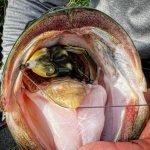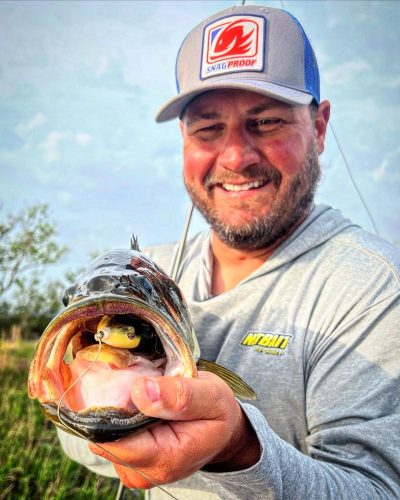Fish Tip Friday – Want to catch bigger bass this fall?
Frog.
By Vance McCullough – AC Insider
While fall fishing is known for producing numbers of bass, big fish can be scarce. The remedy would be to use a big fish technique to specifically target them and forget the schoolers that are eating peanut shad offshore.
Autumn is the top time for froggin’ in many regions of the country as aquatic vegetation has reached its peak growth, forming solid mats across the tops of grass beds. This cover waits enticingly for bass that are starting to migrate back to the shallows for the fall feeding frenzy.
Mind your vegetative varieties for maximum effect. Hydrilla stems are hard, the leaves crunchy, and when water levels are normal-to-low, these mats can be all but impossible for fish to blast through and grab your lure well enough to get hooked. If the grass is already thinning or if water levels suddenly rise and, therefore, stand the hydrilla stalks up vertically, then game on!

Dance that same frog over matted milfoil, peppergrass or eel grass and bass should be able to track it much better and when they strike, they will be able to swallow the frog much more deeply, resulting in solid hookups.
The ultimate froggin’ cover is duck weed. These miniscule floating plants form an ultra-thin surface layer that shades bass below and offers no protection to critters scurrying overhead. Duck weed can blow-in around any cover that would already hold shallow bass, making the spot that much better.
Don’t just think of extensive blankets of greenery when looking for frog fishing opportunities. Isolated sawdust mats are popular flipping and pitching targets, but if the debris canopy is thin enough, frogs are on the menu here too.
Water levels in many places are at their highest in autumn due to ‘king tides’ in coastal regions and just plain old wet weather that tapers off as we ease out of another hurricane season. ‘Open water’ frogs have become a deal in recent years. These sleek models that walk like an old-fashioned spook can be used to nibble the edges of any cover. They skip well back under overhangs and docks, and they glide right through the limbs of gnarly laydowns, making them perfect for fishing around flooded cover of all types as bass move up to gorge on bait before the coming of colder weather.
One tip for fooling more bass on a frog: slow down and pick apart the most obvious targets.
“I mostly just use a frog to work one single piece of cover when I already know there should be a bass there,” noted Major League Fishing veteran pro Cliff Crochet when I shared a boat with him. “If I’m working a big area and I don’t know where to throw, I use a soft plastic buzzing toad. But a hollow bodied frog, like this Bobby’s Perfect Frog from Snagproof, I use that the same way I might use a jig to flip into a specific spot, but in this case the fish are feeding towards the surface,” explained the former deputy from Pier Part Louisiana – where the TV series Swamp People was filmed – in his thick Cajun accent. “Plus, I can throw that frog way back in there while staying off the spot with my boat, so I don’t spook those shallow fish.”
Crochet quickly demonstrated his point by drawing a vicious blow up from a bass that, after a braid-screeching tug of war, pushed the scale to over 6 pounds. It was a scene that would repeat often as Crochet called his shots and caught a stout limit in short order.

One bonus to froggin’ for upsized bass in autumn is you’re still likely to catch good numbers of fish too. But the big idea is to catch big fish.
On that note, gear up for the fight. Heavy braided line and the type of rod that can handle it are key. Something in the range of 7’3”-to- 7’6” is ideal. These days I find myself reaching for a 7’4” medium heavy power rod with a fast action tip. In spite of the name, Lew’s Custom Lite models are great for this salad-tossing tug of war. Another great model is the 7’4” Lee Livesay HFX signature series made by Halo.
I spool my Lew’s Hypermag reel, 7.5:1 gear ratio, with 65lb braid and fish with confidence around any cover.
And remember, when a fish eats, give it about a two-count before slamming those double hooks home.


















